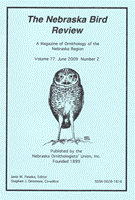Nebraska Ornithologists' Union

Nebraska Bird Review
Date of this Version
6-1988
Document Type
Article
Citation
Nebraska Bird Review (June 1988) 56(2).
Abstract
During the annual spring waterfowl migration, an estimated 5-7 million ducks and geese pass through the Nebraska Rainwater Basins area. The Rainwater Basins area covers all or parts of 17 counties in south-central Nebraska, encompassing some 4,200 square miles. Wetlands of various size, depth, and water permanency are scattered throughout this area. These wetlands are important resting and feeding areas for ducks and geese on their migration north to the breeding grounds. Avian cholera, a highly infectious bacterial disease of waterfowl, has also been an annual visitor to the Rainwater Basins since 1975, killing from as many as an estimated 80,000 birds in 1980 to as few as 300 in 1978 (Nebraska Game and Parks Commission. 1985). The die-off that occurred in the spring of 1975 was the first documentation of avian cholera in Nebraska. Wetlands are monitored by personnel of the U.S. Fish and Wildlife Service and the Nebraska Game and Parks Commission during spring migration in an effort to detect disease outbreaks. Waterfowl carcasses found are collected and incinerated to prevent spread of the disease to healthy birds. A numerical count and determination of species composition of birds picked up from each wetland has been made annually since 1975. The species composition of birds retrieved in 1988 is shown. Beginning in 1984, chronic outbreaks of avian cholera have also occurred in the late fall on Big Sandy Reservoir Number I, located on the National Meat Animal Research Center, near Clay Center in Clay County. Losses have ranged from an estimated 250 birds in 1987 up to as many as an estimated 1,800 in 1986.


Comments
Copyright 1988, Nebraska Ornithologists' Union. Used by permission.